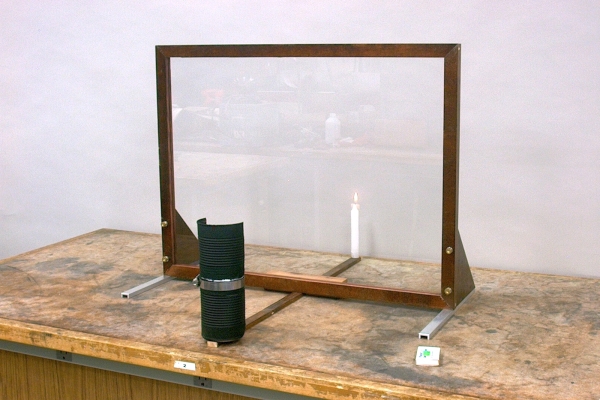
(Thanks to Georgios Koutroulakis for requesting this demonstration.)

(Thanks to Georgios Koutroulakis for requesting this demonstration.)
Light the candle that is hidden inside the black shroud in front of the apparatus. Anyone in the lecture hall whose line of sight to the candle behind the pane of glass, passes through the pane of glass (i.e., is not outside the edges of the pane of glass), sees a flame above the candle. You can place your hand above the apparently lit candle and not get burned, or you can pinch the wick of the candle and the flame stays lit (and, again, you don’t get burned).
When light passes from one medium into another that has a different index of refraction from the first, most of the light passes into the second medium, but some is reflected at the interface. (See demonstration 80.18 -- Refraction tank.) The pane of glass thus acts both as a window, through which we can see the unlit candle behind it, and as a mirror, which reflects the light from the candle flame within the shroud in front of it, back towards us. In the apparatus in the photograph above, the unlit candle and the lit candle in the shroud are equidistant from the pane of glass, on a line perpendicular to it. With this geometry, no matter from what position you view the unlit candle, as long as the line between you and the candle passes through the pane of glass, the angle of this line with respect to the glass equals the angle of an incident ray from the lit candle to the point where the line intersects the glass, and is thus colinear with the reflected ray from the lit candle. You therefore see the flame from the lit candle in the shroud as if it were atop the unlit candle behind the glass, as in the photograph above, and in diagrams below. At left is a schematic view of the apparatus from the top, with the dot in the circle representing the unlit candle, the horizontal line for the pane of glass, and the flame as the lit candle in the shroud. On the right is a drawing representing what is shown in the photograph. In both illustrations, the wedge with the arc respresents the eye of the person viewing the demonstration. (See also demonstration 80.09 – Hinged plane mirrors.)
Please note that, in the right-hand drawing above, the image of the flame is shown at the intersection of the ray from the unlit candle behind the glass, and the reflected ray from the lit candle, to show the coincidence of the transmitted and reflected rays at the front of the glass, and to emphasize that the image of the flame is superimposed on the image of the unlit candle, which makes the candle appear lit. The image of the flame actually appears, as we can see in the photograph above, as if it is behind the glass at the position of the unlit candle. The way this happens is shown clearly in the illustrations for demonstration 80.09, Hinged plane mirrors.